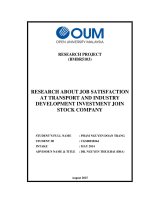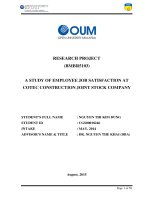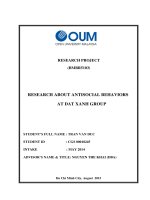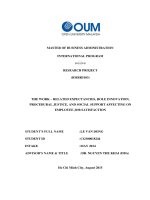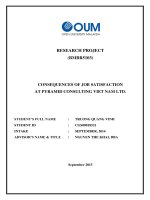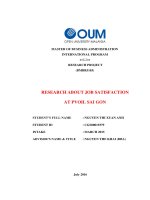Research about job satisfaction at transport and industry development investment join stock company
Bạn đang xem bản rút gọn của tài liệu. Xem và tải ngay bản đầy đủ của tài liệu tại đây (2.99 MB, 61 trang )
RESEARCH PROJECT
(BMBR5103)
RESEARCH ABOUT JOB SATISFACTION
AT TRANSPORT AND INDUSTRY
DEVELOPMENT INVESTMENT JOIN
STOCK COMPANY
STUDENT’S FULL NAME
: PHAM NGUYEN DOAN TRANG
STUDENT ID
: CGS00018264
INTAKE
: MAY 2014
ADVISOR’S NAME & TITLE
: DR. NGUYEN THE KHAI (DBA)
August 2015
ADVISOR’S ASSESSMENT
-----------------------------------------------------------------------------------------------------------------------------------------------------------------------------------------------------------------------------------------------------------------------------------------------------------------------------------------------------------------------------------------------------------------------------------------------------------------------------------------------------------------------------------------------------------------------------------------------------------------------------------------------------------------------------------------------------------------------------------------------------------------------------------------------------------------------------------------------------------------------------------------------------------------------------------------------------------------------------------------------------------------------------------------------------------------------------------------------------------------------------------------------------------------------------------------------------------------------------------------------------------------------------------------------------------------------------------------------------------------------------------------------------------------------------------------------------------------------------------------------------------------
Advisor’s signature
Nguyen The Khai, DBA
Page 1 of 60
ACKNOWLEDGEMENTS
I wish to acknowledge the help of several individuals because without their
assistance, guidance, and understanding this research would not have been possible.
Firstly, I am very grateful to my advisor DBA. Khai Nguyen. His patience, time,
and commitment, in addition to his constant encouragement, effort, constructive
comments,
support,
and
individualized attention
were
a major source of
inspiration. Thank you for trusting in me. The other members of my committee
were also great assets.
Thanks to the board of managers and all employees of TRACODI for their
precious comments and helps to collect data for this thesis.
I wish to give my sincerest and deepest gratitude to my family and all of
my sweet friends for their encouragement, and great support.
Page 2 of 60
TABLE OF CONTENTS
LIST OF FIGURES AND TABLE ....................................................................... 5
ABSTRACT ........................................................................................................... 6
CHAPTER 1: INTRODUCTION ......................................................................... 7
1.1.
INTRODUCTION OF TRACODI .......................................................... 7
1.1.1. Company Description ............................................................................. 7
1.1.2. History and Milestones ........................................................................... 8
1.1.3. Organizational structure of TRACODI ................................................. 11
1.2.
RESEARCH INTRODUCTION ........................................................... 11
1.2.1. Motivation of the study......................................................................... 11
1.2.2. Significance of the study....................................................................... 13
1.2.3. Purpose of the study ............................................................................. 13
1.2.4. Question of the study ............................................................................ 13
CHAPTER 2: LITTERATURE REVIEW ......................................................... 14
2.1
DEFINITION OF CONSTRUCTS ........................................................ 14
2.1.1. Job satisfaction ..................................................................................... 14
2.1.2 Job Interdependence ............................................................................. 14
2.1.3 Supervisory Support ............................................................................. 15
2.1.4 Developmental Experiences.................................................................. 16
2.1.5 Job Role Discretion .............................................................................. 16
2.2.
THEORY OF JOB SATISFACTION ................................................... 18
2.2.1. Job satisfaction theories traceable to employee performance ................ 18
2.2.2. Two-factor theory ................................................................................. 18
CHAPTER 3: RESEARCH MODEL AND HYPOTHESES ............................ 23
3.1
RESEARCH MODEL ............................................................................ 23
3.1.1 Dependent Variables............................................................................. 23
3.1.2 Independent Variables .......................................................................... 23
3.2
CONSTRUCTS ...................................................................................... 24
3.3
SUMMARY OF HYPOTHESES ........................................................... 24
Page 3 of 60
3.4
DATA COLLECTION ........................................................................... 24
3.5
MEASURE OF EACH CONSTRUCT .................................................. 25
3.5.1. Job Satisfaction..................................................................................... 25
3.5.2. Job Interdependence ............................................................................. 27
3.5.3. Supervisory Support ............................................................................. 29
3.5.4. Developmental Experiences.................................................................. 30
3.5.5. Job Role Discretion .............................................................................. 31
3.6
DATA ANALYSIS ................................................................................. 33
CHAPTER 4: ANALYSIS AND RESEARCH................................................... 34
4.1.
DATA ANALYSIS ................................................................................. 34
4.2.
RELIABILITY STATISTICS ............................................................... 35
4.2.1. Main Construct – Job Satisfaction ........................................................ 35
4.2.2. Construct: Job interdependence ............................................................ 35
4.2.3. Construct: Supervisory Support ............................................................ 35
4.2.4. Construct: Developmental Experiences................................................. 35
4.2.5. Construct: Job Role Discretion ............................................................. 36
4.3.
DESCRIPTIVE STATISTICS ............................................................... 36
4.4.
CORRELATIONS STATISTIC ............................................................ 37
4.5.
HYPOTHESIS TESTING RESULTS AND DISCUSSION ................. 39
CHAPTER 5: CONCLUSIONS.......................................................................... 42
5.1.
CONCLUSIONS..................................................................................... 42
5.2.
RECOMMENDATIONS FROM THE RESEARCH RESULTS ........ 42
5.3.
SIGNIFICANCE OF RESEARCH........................................................ 44
5.4.
LIMITATION OF RESEARCH............................................................ 44
5.5.
FURTHER RESEARCH DIRECTIONS .............................................. 44
REFERENCES .................................................................................................... 45
APPENDIX .......................................................................................................... 49
APPENDIX 1: SURVEY .................................................................................. 49
APPENDIX 2: PRESENTATION ................................................................... 57
Page 4 of 60
LIST OF FIGURES AND TABLE
FIGURE
Figure 1: Organizational Chart of TRACODI------------------------------------------- 11
Figure 2: Proposed Research Model of Employee Job Satisfaction in TRACODI 23
TABLE
Table 1: Cronbach's Alpha- Internal consistency .................................................. 34
Table 2: Cronbach's Alpha of Construct Job Satisfaction ...................................... 35
Table 3: Cronbach's Alpha of Construct Job Interdependence .............................. 35
Table 4: Cronbach's Alpha of Construct Supervisory Support ............................... 35
Table 5: Cronbach's Alpha of Construct Developmental Experiences.................... 35
Table 6: Cronbach's Alpha of Construct Job Role Discretion ................................ 36
Table 7: Descriptive Statistics ............................................................................... 36
Table 8: Correlations ............................................................................................ 38
Table 9: Model Summary....................................................................................... 39
Table 10: Coefficientsa ......................................................................................... 40
Table 11: Hypothesis Statistics .............................................................................. 40
Page 5 of 60
ABSTRACT
This purpose of this research is to find the factors influence to the Job
Satisfaction of employees working at TRACODI. This study examines the impact
of Job Interdependence, Supervisory Support, Developmental Experiences, and Job
Role Discretion to Job Satisfaction of employees. Data was collected through the
use of standardized questionnaires. Questionnaires were given personally to 310
managerial and non- managerial employees of TRACODI; there were 290
questionnaires returning, in which 272 completely responses were used for the
statistical analysis. The collected data were computed and analyzed through factor
analysis, Cronbach’s alpha, descriptive statistics, correlation, and multiple
regression analysis. Result: The results support the hypothesis that Job
Interdependence, Supervisory Support, Developmental Experiences, and Job Role
Discretion have positively relationship with employee’s job satisfaction.
Conclusion: The findings in this study would help managers of TRACODI to
formulate strategies that involved work factors such as distributive and procedural
justice to improve the management of human resource development. These
strategies would help to influence positive behaviors among employees, and hence
achieve effectiveness and high productivity in the organization. Therefore, it was
worth the effort for the organization to train and educate their managers on the
impact of perceptions of organizational justice on the motivation and commitment
of their employees.
Keywords: Job satisfaction, Job Interdependence, Supervisory Support,
Developmental Experiences, and Job Role Discretion.
Page 6 of 60
CHAPTER 1: INTRODUCTION
I would like to introduce a research about “Job Satisfaction: Factors affecting
it in Transport And Industry Development Investment Join Stock Company
(TRACODI)”.
1.1.
INTRODUCTION OF TRACODI
1.1.1. Company Description
TRANSPORT AND INDUSTRY DEVELOPMENT
INVESTMENT
(TRACODI)
JOIN
STOCK
COMPANY
was established by the General
Shareholders Meeting on March, 27 2013, it has been
officially changed from one member limited liability
company investments Industrial Development and
Transportation (TRACODI Co., Ltd.) to a joint stock
company since April 04, 2013.
The
precursor
of
TRANSPORT
AND
COMMUNICATION
DEVELOPMENT INVESTMENT JOINT STOCK COMPANY (TRACODI) is
TRANSPORTATION
DEVELOPMENT
INVESTMENT
CORPORATION
(TRACODI) – State-owned Enterprise directly under the Ministry of Transport and
Telecommunications, established under Decision No. 1988/QD/TCCB-LD on
10/30/1990.
Address: 89 Cach Mang Thang 8, Ben Thanh Ward, District 1, Ho Chi Minh
City, Vietnam.
Tel: (84 8) 38330314 - 38330315 - 38323941 to 39259689
Fax: (84 8) 38330317
E-mail:
Website: www.tracodi.com.vn
Tax ID: 0300482393
Page 7 of 60
Spread over more than 20 years of construction and development, TRACODI
constantly sustainable development, stability and assert it position, creating
prestigious brands in the fields of construction traffic , industrial and civil; labor
export service, import and export goods services and tourism services; joint
ventures in the country and abroad; projects investment.
From small initial capital mainly office equipment with less than 10
employees, the Company has developed a long way in all areas of production and
business activities, the Company owns capital can apply to participate in major
projects with over 300 employees and labor management field.
With expanded strategic direction and continued growth, TRACODI is ready
into joint ventures with enterprises at home and abroad for business and production
in the fields of investment, industrial production, construction, labor export, import
and export goods, travel, etc. (“Source: www.tracodi.com.vn”).
1.1.2. History and Milestones
TRACODI is abbreviated from its English name of TRAnsport and
COmmunication Development Investment Joint Stock Company. TRACODI is a
State-owned Enterprise established on 30/10/1990 according to the Decision No.
1190/QD/TCCB-LD issued by the Minister of Ministry of Transport
Stage 1990 – 1995
With the first function of consulting foreign investment in mainly transport
and communication field, TRACODI has successfully consulted many projects as
well as joined many projects with foreign owned capital.
On 02/05/1992 VIETNAM TAXI COMPANY (VINATAXI) was established
between TRACODI and Tecobest Investment Ltd. (Hongkong). This is a public
transportation, calculating charges by taxi meter firstly in Vietnam.
On 24/08/1993 VIKO MIXED ASPHALT AND BATCHED CONCRETE
CO., LTD. (DONGAH-TRACO) was established between TRACODI and
Transport and Communication Mechanical Enterprise No. 2 and Dong-Ah
Construction Industrial Co., Ltd. (Korea),
Page 8 of 60
On 07/09/1994 AN GIANG BUILDING MATERIAL EXPLOITING AND
PROCESSING CO., LTD. (ANTRACO) was established between TRACODI and
An Giang.
On 11/09/1995 TELENZ-TRACODI ENGINEERING INVESTMENT AND
CONSTRUCTION CO., LTD. (TELENZ-TRACODI) was established between
TRACODI and Telenz International Ltd. and Fletcher Construction New Zealand &
South Pacific Limited (New Zealand).
In the years 1994, 1995 construction activity developed, TRACODI was
awarded many industrial projects. Its enterprises were established in turn as
Construction Enterprise No. 1, Construction Enterprise No. 2, Construction
Enterprise No. 3, Construction Enterprise No. 4, Center Construction Enterprise.
On 24/07/1993 LABOUR MANAGEMENT AND TRAINING CENTER
(TRACODI-LAMATCEN) was established.
Also in 1993 Ha Noi People’s Committee granted the Licence for establishing
TRACODI Branch - Representative Office in Ha Noi.
Stage 1996 – 2000
On 30/12/1996 TRACODI co-operated with Thien Nam Co. (Vietnam) and
Caltex Kuo Pte. Ltd. (Singapore) for establishing CALTEX BITUMEN VIETNAM
LIMITED with mainly activity of import, storage, mix, package and distribution of
bitum.
On 18/09/1996 the Department of Tourism granted the licence for establishing
TRACODI TOURIST CENTER (TRACODI TOURIST).
On 18/05/1999 the foreign partner of TELENZ-TRACODI Joint Venture
Company was replaced by Keppel Communication Pte. Ltd. (Singapore) and the
name was changed into FOLEC COMMUNICATIONS VIETNAM LTD. (FOLEC
VIETNAM) by the decision of the Ministry of Planning and Investment.
On 03/07/2000 TRACODI Branch in Da Nang was established.
During years 1997, 1998, 1999, TRACODI met many difficulties such as
many projects had finished yet, outstanding debts from loan for investment.
Page 9 of 60
However, the situation gradually improved by the Board of Directors. TRACODI
recovered and developed step by step.
Stage 2000 – 2005
This stage was developed well in most of fields: construction, labors export,
tourism, joint venture. All activities brought high benefit.
During this period, TRACODI joined a lot of prominent science experiment
projects such as Project of consolidating lime for weak foundation in Mekong River
Delta, Urban Garbage Press Truck Project, Pre-produce House Project for Plain of
Reeds, etc. …
In the end of 2002 TRACODI Party Committee decided to invest the
industrial field for job creation. After many months of study, TRACODI defended
successfully the Pre-feasibility Study Report of Phuong Nam Kenaf Pulp Mill
Project with capacity 100,000 MT/year in Long An province.
Stage 2005 to now
On 23/03/2006 Ground Breaking Ceremony for building Phuong Nam Kenaf
Pulp Mill was held.
During this stage, TRACODI have gathered its strength for investing and
building Phuong Nam Kenaf Pulp Mill. Due to subjective and objective causes,
construction of the Mill has been delayed. TRACODI is facing difficulties of raw
material, professional power source, payment of loan, etc. …
On 16/06/2007 TRACODI was officially conversed into a one member
limited liability company – Transport And Industry Development Investment
Company Limited (TRACODI Co., Ltd.).
In 02/2008 TRACODI made a trial for producing Medium Density Fiber
(MDF) board at Wilhelm-Klauditz-Institut (WKI), Braunschweig, Germany to get
figures for the Feasibility Study Report for investing and building Phuong Nam
Melaleuca Medium Density Fiber Factory (Phuong Nam MDF).
On 10/06/2008 Long An Province People’s Committee and the State Capital
Investment Corporation signed the Transferring Minutes to transfer the right to
Page 10 of 60
represent the State-owned capital in TRACODI from Long An Province People’s
Committee to the State Capital Investment Corporation (SCIC).
In 2008 TRACODI have being implemented to finish the process of restructure company (equitization)
1.1.3. Organizational structure of TRACODI
Figure 1: Organizational Chart of TRACODI
1.2.
RESEARCH INTRODUCTION
1.2.1. Motivation of the study
Human resource is a key factor for the success of an organization. The
satisfaction of their employees which make them work hard to offer to companies.
The measure of employee satisfaction to identify the factors which most impact on
Page 11 of 60
employee satisfaction; Thus it can help companies better understand the level of
satisfaction of employees. From which it can help decision makers to improve the
working environment, use the right people, exploitation of human resources in the
company and bring the highest satisfaction for employees.
Development trend of the economy: The economy is growing and opening up
many opportunities to work for employees. Competition among enterprises is
increasingly high, but people are important resources in creating a competitive
advantage for businesses. The pressures from the economy, from a competitive
market forcing businesses to pay more attention to the human factor in the
organization, including issues made for employee satisfaction.
How can business leaders recognize the system complex needs of workers,
particularly the needs of the "talent". Through the study of the business activities in
Vietnam, the study and understanding of the needs of the workers have not been
implemented on a regular basis and disseminated. The majority of enterprises still
conduct transactions through unofficial channels and not be institutionalized into
the corporate policies. This makes it difficult now to know the heart, the real
aspirations of employees.
Consequence is very improbable that employees feel dissatisfied with their
organization and looking to a new work environment, or still try to maintain but to
work perfunctorily and inefficiently. Moreover, the enterprise does not understand
the needs of employees can create separation, detailed displacement between
groups, the parts together, affect the performance of the business.
For now, in the period of economic integration, competition increasingly
fierce, human resource has an important role in creating a competitive advantage.
Especially with those businesses are on the rise, the search and confirmation its
position on the market as Transport and Industry Development Investment Join
Stock Company (TRACODI) present the more need to pay attention to employee
satisfaction. Promoting the development of the company at present assessing the
satisfaction of the employees is very helpful.
Page 12 of 60
This research can be done as a landmark initial data for comparison during the
development activities in the future the company may increase the satisfaction of
employees? This is the first step for organizations that can increase employee
loyalty to the company
1.2.2. Significance of the study
This study will be conducted from either managerial employees or nonmanagerial employees to exclude the bias of self-report. The opinion of employees
in TRACODI about the impact of job interdependence, supervisory support,
developmental experiences, and job role discretion on TRACODI employee job
satisfaction will be collected to see what the being implemented side evaluates the
company HRM policies.
1.2.3. Purpose of the study
The purpose of the current study is to investigate the impact of job
interdependence, supervisory support, developmental experiences, and job role
discretion on TRACODI employee job satisfaction.
1.2.4. Question of the study
This study addresses some points follow:
-
How is the impact of Job Interdependence on TRACODI employee Job
Satisfaction?
-
How is the impact of Supervisory Support on TRACODI employee Job
Satisfaction?
-
How is the impact of Developmental Experiences on TRACODI employee
Job Satisfaction?
-
How is the impact of Job Role Discretion on TRACODI employee Job
Satisfaction?
Page 13 of 60
CHAPTER 2: LITTERATURE REVIEW
2.1 DEFINITION OF CONSTRUCTS
2.1.1. Job satisfaction
Locke (1969) defined job satisfaction as the extent to which the expectations
that an individual holds for a job match what one actually receives from the job. Job
satisfaction can be characterized as an attitude concerning the extent to which
people like or dislike their jobs (Spector, 1997). There are two common approaches
to the measurement of job satisfaction. The global approach assesses job
satisfaction based on an individual’s overall affective reaction to his or her job. By
contrast, the composite approach examines the pattern of attitudes a person holds
regarding various facets of the job such as coworkers, fringe benefits, job
conditions, nature of the work itself, policies and procedures, pay, and supervision
(Spector, 1997). Individuals often differ in their degree of satisfaction across facets
(e.g., someone may be very satisfied with supervision, but dissatisfied with pay).
The distinction between the two measurement approaches is important as research
has shown that there are only modest correlations between global and composite
measures of job satisfaction (Scarpello & Campbell, 1983).
2.1.2. Job Interdependence
Job interdependence is a job attribute that has demonstrated motivational
effects in many studies (Kiggundu, 1981, 1983; Van der Vegt & Van De Vliert,
2005; Wageman, 1995). More specifically, studies have reported a positive
relationship between task interdependence and extrarole or cooperative behavior
(Anderson & Williams, 1996; Pearce & Gregersen, 1991; Wageman & Baker,
1997). While some of these researchers have divided task interdependence into
“initiated” and “received” components, for our purposes we combined these into
“reciprocated” task interdependence, as developed by Pearce and
Gregersen
(1991), accepting their argument that initiated and received interdependence have
too high a covariance to be viewed as independent constructs. Regardless of the
type of task interdependence studied, one theoretical basis as to why task
Page 14 of 60
interdependence leads to cooperative behavior is that the interactive nature of the
tasks contributes to experienced responsibility for the other’s outcomes (Kiggundu,
1983; Pearce & Gregersen, 1991).
A second theoretical grounding for the
motivating effects of task interdependence relies on the view that an employee with
a long-term time horizon will contribute to other workers efforts if they believe
their coworkers will reciprocate. This common human tendency has been
incorporated into organizational behavior literature from sociology, namely from
social exchange theory (Blau, 1964), and the norm of reciprocity (Gouldner, 1960).
2.1.3. Supervisory Support
Supervisor support is defined as employees’ belief concerning the extent to
which supervisors value their contributions and care about their well-being.
Employees need motivation to expend greater efforts and more personal resources
in innovative tasks when supervisor exhibit their individual consideration toward
followers, followers are likely to perceive the warmth and consideration from their
supervisors. Similarly, employees who perceive support from their supervisors
often feel obligated to pay back supervisors’ favors or kindness by helping
supervisors to reach their stated goals (Eisenberger et al. 2002). Jung et al. (2003)
indicated that leadership is positively associated with employee-perceived
empowerment and support for innovation. Creativity and innovation is an area
where supervisors can have a strong impact on employee creativity through their
influence on the context within which employees work (Shalley and Gilson, 2004).
In order for innovative behavior to occur, supervisor needs to foster, encourage, and
support creativity (Shalley and Gilson, 2004).
Janssen (2003) found evidence that employees responded more innovatively
to higher levels of job demands when they perceived that their efforts were fairly
rewarded by their supervisor. Oldham and Cummings (1996) found that supportive,
non-controlling supervisors created a work environment that fostered creativity.
Open interactions with supervisors and the receipt of encouragement and support
lead to enhanced employee creativity (Tierney, Farmer, and Graen 1999). This
Page 15 of 60
means that employees who perceive a fair balance between supervisor’s
inducements relative to their work efforts will respond with more innovative
behavior. According to social exchange theory additional arguments can be derived
for a relationship between supervisor support and innovative behavior. Direct
supervisors can act as organizational agents. Employees tend to view actions by
agents of the organization as actions of the organization itself. Therefore, they
reward favorable supervisor treatment with desired behaviors.
2.1.4. Developmental Experiences
Developmental job experience as an individual’s experience of taking on
demanding assignments that offer opportunity for learning and leadership. The
extent to which an assignment brings developmental job experience can depend on
how the particular employee views the opportunity in his or her own mind.
Developmental assignments usually share some common features: unfamiliar
responsibilities, opportunity to create change, high levels of responsibility, working
across boundaries, and managing diversity. (Yuntao Dong, Myeong-Gu Seo, and
Kathryn M. Bartol, 2014)
Developmental job experience is associated with growth and future benefits as
well as with substantial risks and uncertainty. Depending on whether an individual
perceives the assignment as a challenge or a threat, combined with their ability to
use coping skills, he or she will experience pleasant or unpleasant feelings. These
feelings lead to an overall positive or negative outcome. The authors examined
advancement potential as a positive outcome and turnover intention as a negative
outcome in the study. The authors explained that because developmental job
experience can contribute to both pleasant and unpleasant feelings at the same time,
both positive and negative outcomes can occur.
2.1.5. Job Role Discretion
The notion of discretion occurs when someone has the freedom and authority
to take action and is aware of this freedom (Finkelstem et al., 2009, p. 26; Hackman
& Oldham, 1975). A definition on discretion in the English Dictionary for
Page 16 of 60
Advanced Learners (2001, p. 435) is: “if someone in a position of authority uses
their discretion or has the discretion to do something in a particular situation, (hey
have the freedom and authority to decide what to do”. It may occur in different
forms like employee, job or managerial discretion that all are used in the literature.
This study takes the main focus on job discretion that is involved with the extent of
discretion that belongs to a certain job. Job discretion can be seen as an extension of
the concept of managerial discretion. Furthermore, job discretion is closely related
to the concept of job autonomy. Both managerial discretion and job autonomy are
discussed to provide insights on the differences and similarities, resulting in better
understanding of job discretion.
This is also known as “job autonomy” and is explained in the organizational
behavior literature by Hackman and Oldham (1975, p. 162) as “the degree to which
the job provides substantial freedom, independence, and discretion to the employee
in scheduling the work and in determining the procedures to be used in carrying it
out”. Employees are given discretion by their employers to carry out tasks to be
completed in a specified amount of time, rather than being told what to do at every
moment (Prendergast, 2002). This implies that job autonomy refers to the extent of
discretion about how to execute the job. Therefore discretion and autonomy are
similar in addressing the extent of freedom in organizational or work related
decisions and thus these concepts are tightly linked to each other.
All employees have a certain degree of discretion that is given by the way
their job is designed. It is clear that an agency issue may arise within the
employment relationship when an organization provides more discretion towards
the employees. An employee will try to maximize his own value at (lie expense of
the organization, meanwhile the organization wishes to maximize profit. This
conflict of interest illustrates a fundamental agency problem and is quite general,
since it exists in all organizations and in all cooperative efforts (Jensen & Meckling,
1976). Higher job discretion provides more leeway to the employee to choose from
a certain range of effort levels. In order to sustain effort at higher levels of
Page 17 of 60
discretion and induce workers not to settle at their lowest possible point in the effort
range, an organization must provide a financial motivation.
2.2. THEORY OF JOB SATISFACTION
2.2.1. Job satisfaction theories traceable to employee performance
Job satisfaction at its most general conceptualization, is simply how content
an individual is with his job. Simply stated, job satisfaction refers to the attributes
and feelings people have about their work. Positive and favourable attitudes
towards the job indicate job satisfaction. Negative and unfavourable attitudes
towards the job indicate job dissatisfaction Armstrong (2003). This satisfaction may
be affective: one-dimensional subjective construct representing an overall
emotional feeling individuals have about their job as a whole Kalleberg (1977) and
Moorman (1993).
It may also be cognitive: more objective or logical evaluation of various facets
of a job. Cognitive job satisfaction does not assess the degree of pleasure or
happiness that arises from specific job facets, but rather gauges the extent to which
those job facets are judged by the job holder to be satisfactory in comparison with
objectives they themselves set or with other jobs. The two constructs are distinct,
not directly related, have different antecedents and consequences though cognitive
job satisfaction might help to bring about affective job satisfaction in the
organization.
2.2.2. Two-factor theory
Among the content theories of motivation, Herzberg (1959) theory
emphasizing the motivator-hygiene factors sought to explain satisfaction and
motivation in the organization. The theory focuses on outcomes of satisfaction and
dissatisfaction. The theory further found that certain aspects of a job cause
satisfaction and therefore motivation, but certain aspects caused job dissatisfaction.
Herzberg explained that the factors that lead to satisfaction or to dissatisfaction are
different. Accordingly, he states that ‘the opposite of job satisfaction is not job
dissatisfaction but, rather, no satisfaction; and the opposite of job dissatisfaction is
Page 18 of 60
not job satisfaction but no satisfaction’ (Herzberg, 2003.91). This theory states that
job satisfaction and dissatisfaction is a product of different factors - motivation and
hygiene respectively. Motivation is seen as an inner force that drives individuals to
attain personal and organizational goals. Motivational factors are those aspects of
the job that make people want to perform and provide people with satisfaction.
Hygiene factors include aspects of the working environment like working
conditions, interpersonal matters, organizational policies and so on (Hackman &
Oldham, 1976). Factors that relate to job satisfaction are therefore called satisfiers
or motivators. According to Weir (1976) and Syptak, Marsland & Ulmer (1999),
the following factors stood out as ‘strong determinants of job satisfaction’.
Achievement: This requires helping and placing employees in position that
use their talents and not to set up for failure. It is achieved by setting clear,
achievable goals and standards for each position, and making sure employees know
what those goals and strategies are. Individuals should also receive regular, timely
feedback on how they are doing and feel they are adequately challenged in their
jobs.
Recognition: Refers to the honour, favourable note or attention given to an
employee for a ‘job well done’ or an outstanding behaviour. Individuals at all levels
in the organization want to be recognized for their achievement on the job. The
individual’s success does not have to be monumental before they deserve
recognition. Employees should be acknowledged for doing something well
immediately after their good work. Publicly appreciating them for finding solutions
to a problem, writing a note of praise, establishing a formal recognition program
like ‘employee of the month or year’, making periodic reports directly available to
the employees themselves rather than to management, are some of the ways of
recognizing employees.
Work itself: This involves helping employees believe that the task they are
doing is important and meaningful. Setting goals and reminding and emphasizing
that their efforts lead to and contribute to positive outcomes and goal
Page 19 of 60
accomplishment is crucial. Success stories and cases should be shared on how an
employee’s actions made a real difference in the organization. Also show
employees how their work is essential to the overall processes that make the
practice succeed. Unnecessary tasks can be eliminated or streamlined to bring about
greater efficiency in the organization.
Responsibility: Responsibility is taken action for ones actions. Granting
additional authority to employees in their activity, giving them enough job freedom
and power so that they feel they ‘own’ the results are ways of giving them
responsibility. As employees grow, they can be provided opportunities for added
responsibility by adding challenging and meaningful work.
Opportunity for advancement or promotion: This involves electing
employees from the present job or position to a higher one or level in the
organization. If possible permit and support them to acquire higher certificates so
that they could become experts themselves and make them more valuable to the
practice and more fulfilled individuals.
Factors that relate to job dissatisfaction (dissatisfiers or hygiene factors) as
explained by Herzberg are:
Pay (salary): Organizations, they say, ‘pay get what they pay for’. Salary is a
contractual agreement between the employer and the employee. It not a motivator
for them but do want to be paid fairly and when due. If an employee perceives that
he is not fairly compensated, he will not be happy and so slow the pace of
performance. Comparable salaries and benefits, clear policies relating to salaries,
increments, bonuses and benefits must be clearly indicated to avoid dissatisfaction.
Supervision: This involves technical and general supervision in the
organization. Wise decisions should be taken when it comes to appointing someone
to the role of supervising. This role is difficult and requires good leadership skills
and the ability to treat all employees fairly. There should also be positive feedback
and a set means of evaluating or appraising employees.
Page 20 of 60
Working conditions: The environment under which employees work has a
tremendous effect on their level of pride for themselves and for the work they do.
The provision of modern equipment and facilities, quality furniture, well ventilated
offices, well spaced offices, secured, well spaced staff quarters, and so on are some
of the conditions that are required to prevent job dissatisfaction in the organization.
Company policies, administration and procedures: An organization’s
policies, administration and procedures can be a great source of frustration for
employees if the policies and procedures are unclear or unnecessary or if those to
follow are selected. A policy permits an employee to use his discretion and
initiatives in the discharge of his duties. Policies may not make employees satisfied
and motivated but it can decrease dissatisfaction by making policies fair and
applicable to all. Policy issues should be documented (manual) and distributed to
employees, their inputs should be solicited for while comparing policies to those of
similar practices. Policies should also be reviewed from time to time. Helping
employees to use their initiatives can also go a long way in preventing
dissatisfaction.
Interpersonal relationships: Relating well with peers, managers and
subordinates encourages job dissatisfaction. Part of the satisfaction in employment
contract is the social contact it brings to employees. Reasonable time should be
given for socializing. This will help to develop a sense of teamwork and at the same
time cracking down on rudeness, difficult behaviour and offensive comments.
People should be encouraged to live in harmony irrespective of cultural and other
diversities.
Status: This is a person’s social rank in a group, which often is determined by
a person’s characteristics, in addition to the person’s formal position. When status
differ, it may be difficult to communicate effectively in the organization. To reduce
dissatisfaction, managers should use both verbal and nonverbal forms of
communications to pass messages to employees with the highest level of
probability that the information circulated will be intact. The issue of status should
Page 21 of 60
also be diluted to avoid a situation whereby those with higher status will not
influence members having lower status. Individual status should not be a yard stick
for motivation.
Security: Security in this case refers to job security - freedom from threats of
layoffs, frequent queries, harassment, discrimination, bullying and so on. When
there is no job security, an employee’s needs for higher growth will be blocked. If
he works hard but security does not return, he will seek to fulfil his needs elsewhere
or burn out. While motivators are part of the job content and relate to what people
actually do in their work hygiene or dissatisfies are often associated with job
context: associated more to the work setting than the nature of work itself.
Page 22 of 60
CHAPTER 3: RESEARCH MODEL AND HYPOTHESES
The primary goal of this study is to investigate the effects of Job
Interdependence, Supervisory Support, Developmental Experiences, and Job Role
Discretion to employee Job Satisfaction in TRACODI. The methodology
specifically described the research model, the research instrument, the research
hypothesis, data collection process, and the procedure for the data analysis.
3.1 RESEARCH MODEL
Job Interdependence
+
H1
Supervisory Support
Developmental
Experiences
+
+
H2
H3
Job Satisfaction
H4
+
Job Role Discretion
Figure 2: Proposed Research Model of Employee Job Satisfaction in TRACODI
3.1.1 Dependent Variables
-
Job Satisfaction
3.1.2 Independent Variables
-
Job Interdependence
-
Supervisory Support
-
Developmental Experiences
-
Job Role Discretion
Page 23 of 60
3.2 CONSTRUCTS
-
Key construct: Job Satisfaction (JS)
-
Other constructs:
Job Interdependence (JI)
Supervisory Support (SS)
Developmental Experiences (DE)
Job Role Discretion (JRD)
3.3 SUMMARY OF HYPOTHESES
My model suggests that the effects of Job Interdependence, Supervisory
Support, Developmental Experiences, and Job Role Discretion to employee Job
Satisfaction. Thus, the following hypotheses are proposed:
Hypotheses 1: Job Interdependence will be positively related to employee
job satisfaction in TRACODI
Hypotheses 2: Supervisory Support will be positively related to employee
job satisfaction in TRACODI
Hypotheses 3: Developmental Experiences will be positively related to
employee job satisfaction in TRACODI
Hypotheses 4: Job Role Discretion will be positively related to employee
job satisfaction in TRACODI
3.4
DATA COLLECTION
The sample of this study consists of managerial employees and non-
managerial employees from TRACODI. The questionnaires were personally given
to managerial and non-managerial employees of TRACODI during the month of
June and July, 2015. Only completed questionnaires are collected and used to
analyze.
The questionnaires were sent out by email to all 310 employees for printing
out and fill in. 290 responses were returned in which only 272 were usable. Making
the overall response rate at around 88 percent. The data analyses used in this
research are based on the survey results of these 272 respondents.
Page 24 of 60


